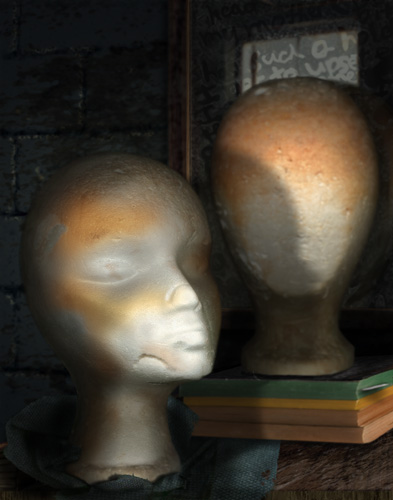 |
 |
Original 14" x 11", 150 dpi |

|
| notes |
In "The Two Sisters," the central forms are two styrofoam wig mannequins, apparently placed for display on a rough looking wooden surface, atop a crumpled cloth and a stack of paperback books. One head has the rudiments of facial features, while the other one has a smooth plane where there would be a face. The one with the face casts the other behind it half in shadow. A dust-covered mirror stands behind them, dimly reflecting the heads. Manic writing is smudged across the mirror in the dust. A mold-covered cinder block wall is the backdrop, which, with the dim lighting, possibly suggests a basement.
There is a direct allusion to the Giorgio de Chirico painting of the same name, which had much the same content, though his wasn't a presentation of literal objects but instead more enigmatic. The comparison and allusion is important however, because the feeling is somewhat the same even when found in the literal objects--the heads are unsettling because of the distorted and incomplete way in which they act as surrogates for human heads and faces--there are enough cues there to trigger the association, but enough discrepancies to create a disturbing alienation.
This image fits in with earlier paintings of mine as sort of parodies of traditional still life paintings (https://postdlf.tripod.com/nonsense/painting.html). The devices are repeated, with objects placed on display atop a surface, with accessories of cloth and book framing them, but the objects being portrayed are cheap modern consumer goods. My belief is that there are no subject matters unworthy of being made into art, except perhaps that which isn't a part of our lives or experience. In our culture, we buy and throw out plenty of crap that we don't take a second look at, and yet bit by bit these trinkets and trash are creating the substance of our lives, through the time and resources they occupy, and through the associations that they are infused with even through casual contact.
"The Two Sisters" was also a technical challenge I wished to achieve, in that it was the first time that I had digitally composited an imaginary scene and space. All of my previous digital works were immediately readable as collage--I wanted to try something that wasn't, and so whatever wasn't taken from a scan of an object's side was painted in with the software. There were no photographs used.
This work was shown in:
"More of the Same," OSU BFA senior exhibition
The gallery formerly known as the Silver Image Gallery, Haskett Hall, Columbus, OH
Feb 21-23
|




